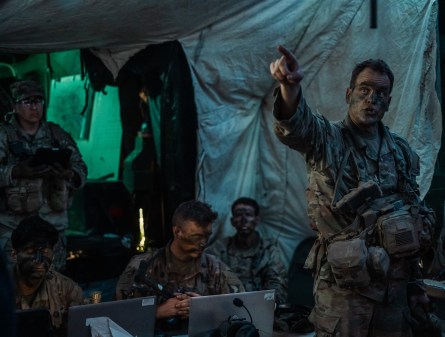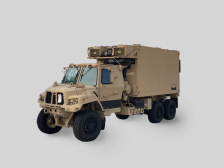Northrop puts its airborne intelligence node to the test

Northrop Grumman recently completed testing of its airborne deep-sensing architecture in an Army prototyping event aimed at helping solve gaps with long-range precision fires.
The Deep-Sensing and Targeting (DSaT) capability is a multi-domain tool that’s integrated into a civilian aircraft for intelligence collection beyond the visual line of sight.
The system was put through its paces at the Army’s Vanguard 24, an annual capstone event testing various technologies and prototypes to integrate them into intelligence system architectures for evaluation and to inform decisions about whether they’ll become future Army programs of record.
Northrop is trying to help the Army address some of the challenges associated with its long-range precision fires mission.
“What we were identifying on our side is that they have challenges with over-the-horizon capabilities,” Brent Swift, director of Northrop Grumman’s mission exploitation operating unit, said in an interview. “If you think about the ability for a multi-domain conflict, you’re not constrained by terrestrial ground, sea or space. In this instance, we’re particularly exploiting an airborne-type capability. If you think about the ability to extend your capabilities over the constraints that you deal with from a sea or terrestrial perspective, DSaT and being airborne is a game changer for the Army that typically focuses on terrestrial or ground-based capability. That’s the difference maker that I think DSaT has.”
The contractor provided the Army’s pre-prototypes for the Tactical Intelligence Targeting Access Node (TITAN) system, before the official program of record, leveraging that ground work to mount DSaT on a jet aircraft.
“DSaT is really taking a ground station, putting it on an airborne platform and really processing that intelligence data, moving the needle from a multi-domain perspective and then getting the warfighter the data faster than they’ve ever had it before,” Swift said. “It’s designed to pull down commercial and military data from space-based capabilities. Basically, we’re putting it in a form factor that will integrate into commercial aircraft versus what we typically have from a large, robust ground site.”
A jet provides the advantage of seeing over the horizon and increasing the range. “That’s really what puts the decision data in the hands of the shooter for their target nominations,” he said.
“You’re kind of limited on a terrestrial ground site by the line of sight that you have. And putting it airborne into that aircraft gets you over that horizon, visual line of sight, and then you’re able to exploit the sensors that are on that aircraft,” Swift added.
While he declined to comment on the acquisition and program of record for the Army’s High Accuracy Detection and Exploitation System (HADES) system — the service’s business jet program to conduct intelligence, surveillance and reconnaissance — Swift suggested the capabilities that DSaT provides would aid that program.
“When you think about some of the [military’s] areas of responsibility and how they execute their missions, we saw a need for where they were going with their HADES program and how we could potentially help them move the needle from having an airborne-type direct downlink capability,” he said. “When we think about the types of missions HADES would support and perform, we identify that it could potentially leverage our capabilities. We’ll certainly propose the ability to leverage that capability, but ultimately, the customer has a decision on how they acquire and how they close the loop on that mission it’s going to support.”
While not officially on contract for a program for DSaT, Northrop has been awarded prototyping money to continue testing the system.
The work at Vanguard 24 built upon prior work the company did at the Army’s EDGE experiment last year.
Swift said the organization used surrogate jets to fly DSaT at Vanguard and tested communications with the intelligence data on the aircraft, then disseminated it to the exercise operators.
He declined to offer more specific details regarding what the system did at the exercise but noted the company delivered on objectives, leveraging space-based data to deliver targeting nominations, took line of sight and beyond-line-of-sight capabilities to ensure they could continuously communicate, and then demonstrated how to insert and integrate AI technologies.
Swift added that during this go-round they used artificial intelligence and machine learning capabilities “that directly improved efficiency, accuracy, speed to deliver data into the hands of the operator.”
Following Vanguard, Northrop anticipates follow-on DSaT activity for more engineering.
“We want to continue to put what’s within the possibility in front of the decision makers to help them understand how they can close the kill chain,” he said.





